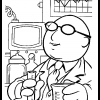I´m posting this in General Discussion because I have no idea where else to discuss it.
I´m writing up a Procedure about how to deal with Bodily Fluids. I´m having trouble with the part about how to clean up bodily fluids. I´m up to the part when you´ve already gotten rid of the contaminated product, but how do I clean the surface?  Use a high pressure jet of water and detergent is probably the easiest answer, but what about if this were to happen inside a concrete or metal silo? How would I get the water out afterwards? Or what if it´s a wooden surface? (I know, I know, we shouldn´t have wooden surfaces, but so far local legislation hasn´t banned it in food facilities, so please bear with me.)
Use a high pressure jet of water and detergent is probably the easiest answer, but what about if this were to happen inside a concrete or metal silo? How would I get the water out afterwards? Or what if it´s a wooden surface? (I know, I know, we shouldn´t have wooden surfaces, but so far local legislation hasn´t banned it in food facilities, so please bear with me.)
Anybody have any ideas?
Below is what i have. Must admit i plagarized some of it from the NHS.
I also have Bodily Fluid Spill Kits which i purchased from Setons (www.setons.co.uk) and we have a plastic box in a production area which contains gloves, apron, bags and Hypo tablets
3.7. Potential contamination by Bodily Fluids
Dealing with spills of blood or other bodily fluids may expose the worker and the product to blood -borne viruses or other pathogens.
Body fluids include:
Blood
Respiratory and oral secretions
Vomit
Vaginal secretions
Amniotic fluid
Faeces
Urine
Wound drainage
Semen
Cerebrospinal fluid
Pleural fluid
Gastric
Aspiration
Breast milk
3.8. Routine Safety Procedures
Deal with any spillage of blood/bodily fluids immediately. PLEASE ENSURE THAT IT IS SAFE TO DO SO.
Care must be taken to avoid skin, eye, and mucous membrane contamination during the cleaning and disinfection of spillages, protective clothing must be worn. This protective clothing is to be changed once the spillage has been cleared.
Staff must always cover cuts and lesions with a waterproof metal detectable blue dressing whilst on duty.
3.9. Protective Clothing
Wear plastic disposal apron.
Wear disposable gloves.
Protect eyes and mouth with goggles and mask (or full face visor) if splash or spray is anticipated.
3.10. Disinfection of Blood and Bodily Fluid Spills
Disinfection aims to reduce the number of microorganisms to a safe level. Whilst a variety of chemical disinfectants are available, high concentration chlorine-releasing compounds provide an effective method of treating bodily fluid spills with activity against a range of bacteria and viruses. For clarity a chlorine releasing agent may be used.
The disinfection solution is expressed as parts per million (ppm) of available chlorine:
10,000 ppm for blood spillages.
1,000 ppm for general disinfection.
Caz x



















